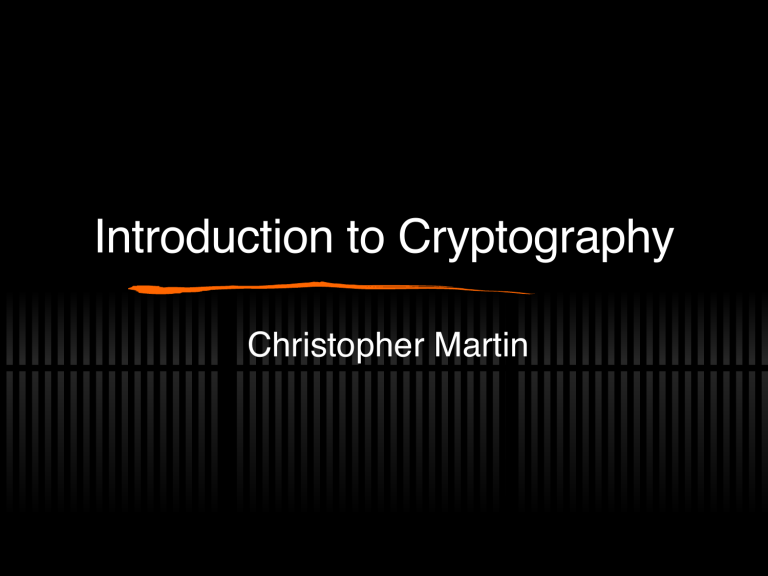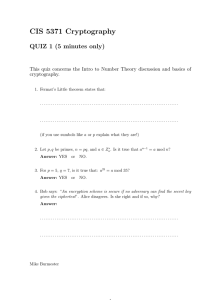
Introduction to Cryptography Christopher Martin What is Cryptography? “There are two kinds of cryptography in the world: the kind that will keep your kid sister from reading your files, and the kind that will keep major governments from reading your files” - Bruce Schneier, preface to Applied Cryptography Cryptography is the science of keeping things secret, this is known formally as confidentiality. Cryptography can be asked to do other things as well. But what can crypto do for me? Authentication Proof of identity Integrity Proof of content Nonrepudiation Proof of transmission Terminology 1. Plaintext or Cleartext • • Ciphertext • • The encrypted message Encryption or Enciphering • • • The message The process of turning plaintext into ciphertext E(M) = C Decryption or Deciphering • • The opposite of the above D(C) = M or D(E(M)) = M Son of Terminology 1. Cryptography • • • Cryptanalysis • • • Art and science of keeping secrets secret Practitioners are called Cryptographers The art and science of making secrets not. Breaking Cryptography Practitioners are called Cryptanalysts Cryptology • • The branch of mathematics that encompasses both of the above. Practitioners are called Cryptologists Return of Son of Terminology 1. Key • • • Cryptographic Algorithm • • • The “shared secret” used to keep the message secret. Can be one value from any sized range, called the keyspace The series of steps applied to the message and the key Also called a cipher Cryptosystem • A single algorithm, plus all possible plaintexts, ciphertexts, and keys A brief digression on secrecy All secrecy resides in the key Kerchoffs’ Law Restricted Algorithms Types of encryption algorithms Asymmetric Also known as public key Uses two keys, public and private Symmetric Uses one key that is shared between parties Historical/Classical Substitution ciphers, polyalphabetic cipers, codes Hash Not technically encryption algorithms but are part of cryptography Symmetric Encryption Ek(M) = C, Dk(C) = M, Dk(Ek(M)) = M The encryption key can be calculated from the decryption key, and vice versa Usually, however, there is only one key The primary Achilles heel is that the key must be shared between n parties DES, 3DES, Blowfish, Twofish, Serpent, IDEA, AES (Rijndael) Can operate in two modes: stream and block, and most modern algorithms have variable key size One Time Pads Subset of Symmetric ciphers Offers theoretically perfect security Key is comprised of a large sheet of truly random letters. Each key is used only once Encryption is the addition modulo 26 of the key letter, and the plaintext letter Asymmetric Encryption Ek-pub(M) = C, Dk-priv(C) = M, Dk-priv(Ek-pub(M)) = M Given the public key, it is computationally infeasible to calculate the private key Can also be used for digital signatures Examples: RSA, DSA, ElGamal,Diffe-Hellman Hashing Algorithms Hashing is about integrity There is no key involved in hashing Takes an arbitrary sized input, and produces a unique fixed size output The smallest change in the input should produce a totally different output The process is non reversible Examples: MD4, MD5, SHA-1, SHA-128, SHA256 Attacking Cryptography Cryptanalysis Ciphertext Only Attack Known Plaintext Attack Chosen Plaintext Attack Adaptive chosen plaintext Chosen Ciphertext Attack Chosen Key Attack Rubber Hose Cryptanalysis Where to use cryptography? Anywhere you want to have something remain secret SSL, TLS, IPv6, SSH, IPSec all keep information secure in transit Any Symmetric Algorithm can keep your files safe in storage There are file systems available that will encrypt your data on the fly. EncFS and Loop-AES for unix, EFS for windows, FileVault for Mac OS X You can add encryption at the application level, or at the server level for storing database information securely Where can I get cryptography? Your best bet it to have it bundled with the Operating System, or to buy supported add-on hardware that does what you want. OpenBSD is the de facto standard for operating system supported cryptography. Add on libraries like OpenSSL and libTomCrypt are also available for most unix like platforms. Roll Your Own Not really recommended unless you are an expert Conclusions Cryptography is only one part of a multi layered security system It’s not a magic bullet It’s fun Sources • Applied Cryptography, Bruce Schneier 1996, Wiley and Sons • Practical Cryptography, Bruce Schneier and Niels Ferguson 2003, Wiley Publishing • Silence on the Wire, Michael Zalewski 2005, No Starch Press




